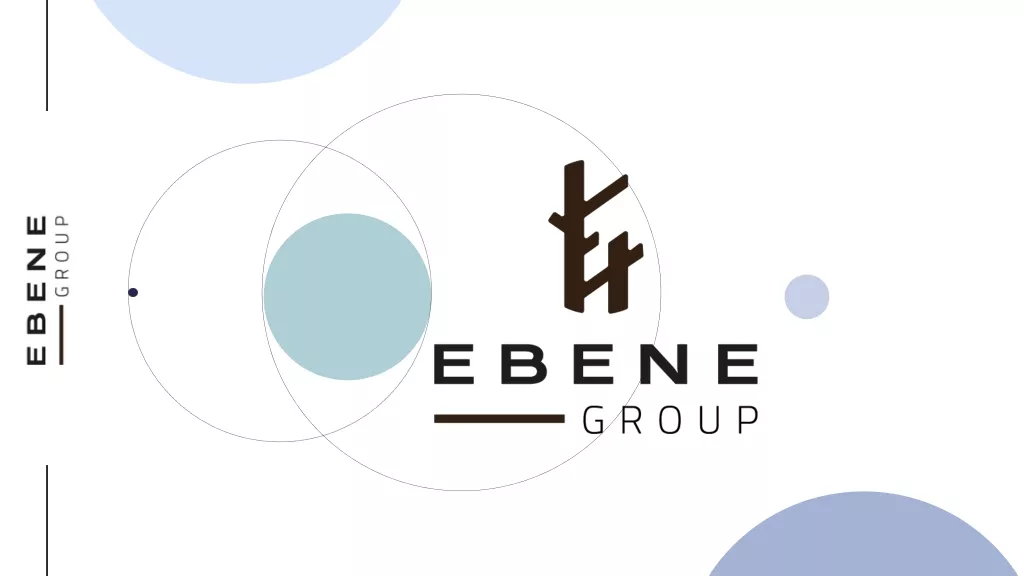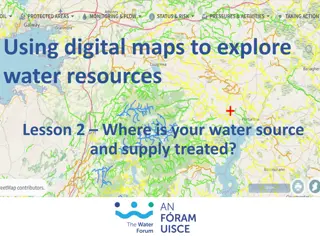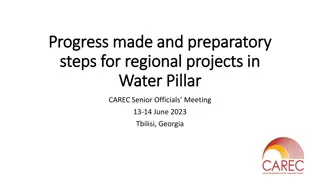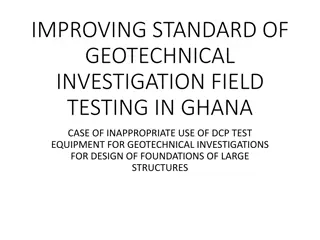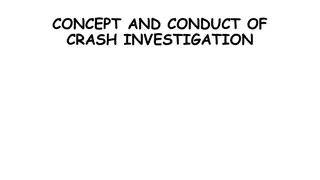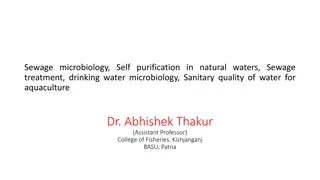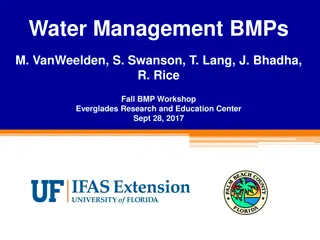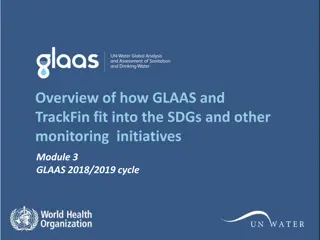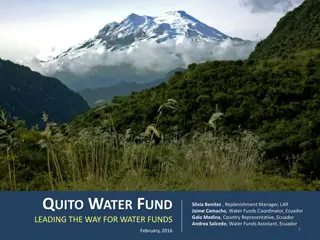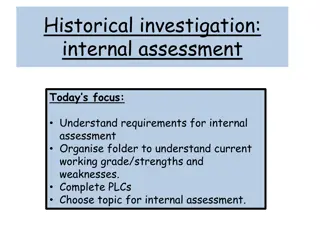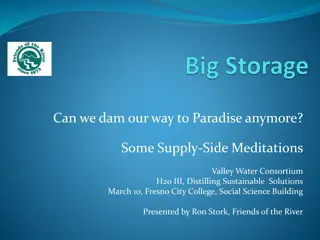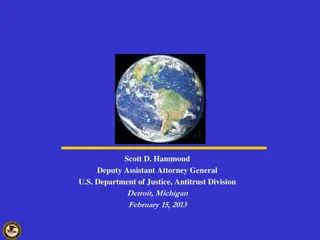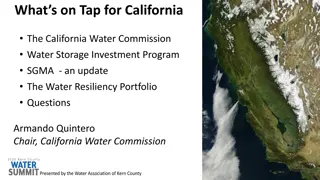
Innovative Water Sustainability Project for Students
Explore a project focusing on water sustainability challenges where students work collaboratively to investigate and address issues related to the global availability of freshwater and its sustainable use. By selecting from various research areas, students engage in hands-on learning, problem-solving tasks, and collaborative projects to develop a deeper understanding of the importance of access to clean water and sanitation.
Download Presentation

Please find below an Image/Link to download the presentation.
The content on the website is provided AS IS for your information and personal use only. It may not be sold, licensed, or shared on other websites without obtaining consent from the author. If you encounter any issues during the download, it is possible that the publisher has removed the file from their server.
You are allowed to download the files provided on this website for personal or commercial use, subject to the condition that they are used lawfully. All files are the property of their respective owners.
The content on the website is provided AS IS for your information and personal use only. It may not be sold, licensed, or shared on other websites without obtaining consent from the author.
E N D
Presentation Transcript
ne m Dr Adele Hudson and Dr Kshitija Dhuna Aitken College STAV VCE Conference, 15 February 2023, University of Melbourne ahudson@aitkencollege.edu.au kdhuna@aitkencollege.edu.au Resources www.mychemhub.com
Principles behind curriculum design Design of projects is based on 7 principles of GIST Focus Focus hands-on learning context-based learning problem solving tasks collaborative learning
Benefits of context-based learning For students For students Stronger connection to subject Stronger connections within class Stronger connections to content For teachers For teachers Efficient way to develop new SACs by use new context with same measurement techniques Unique contexts reduce opportunities for plagiarism
Project Description Ensuring access to water and sanitation for all, is one of the goals set by the United Nations to address current global challenges. In recent years, progress has been made in ensuring more people have access to reliable drinking water. However, there is increasing pressure on the availability of freshwater with demand for agriculture use doubling in the past 30 years (Our world in data, n.d). With increasing use there has been greater degradation of the quality of water with almost half of rivers and streams in many countries being unfit for drinking, swimming or fishing. In this project, students select from four different research areas to design an investigation into issues related to sustainable use of water.
Project Description Ensuring access to water and sanitation for all, is one of the goals set by the United Nations to address current global challenges. In recent years, progress has been made in ensuring more people have access to reliable drinking water. However, there is increasing pressure on the availability of freshwater with demand for agriculture use doubling in the past 30 years (Our world in data, n.d). With increasing use there has been greater degradation of the quality of water with almost half of rivers and streams in many countries being unfit for drinking, swimming or fishing. In this project, students select from four different research areas to design an investigation into issues related to sustainable use of water.
The students complete individual Project Description projects whilst working in a research group. In their research group they Ensuring access to water and sanitation for all, is one of the goals set by the United support each other by discussing their Nations to address current global challenges. In recent years, progress has been ideas and collaborating with data made in ensuring more people have access to reliable drinking water. However, collection. there is increasing pressure on the availability of freshwater with demand for agriculture use doubling in the past 30 years (Our world in data, n.d). With increasing use there has been greater degradation of the quality of water with almost half of rivers and streams in many countries being unfit for drinking, swimming or fishing. In this project, students select from four different research areas to design an investigation into issues related to sustainable use of water.
The students complete individual Project Description projects whilst working in a research group. In their research group they Ensuring access to water and sanitation for all, is one of the goals set by the United support each other by discussing their Nations to address current global challenges. In recent years, progress has been ideas and collaborating with data made in ensuring more people have access to reliable drinking water. However, The four research areas include: collection. there is increasing pressure on the availability of freshwater with demand for 1. Clean water for disaster relief agriculture use doubling in the past 30 years (Our world in data, n.d). With 2. Drinking water treatment increasing use there has been greater degradation of the quality of water with 3. Treatment of industrial almost half of rivers and streams in many countries being unfit for drinking, contaminated water swimming or fishing. In this project, students select from four different research 4. Water for agriculture areas to design an investigation into issues related to sustainable use of water.
Clean water for disaster relief When a disaster strikes a country, whether it is an earthquake, a tsunami or floods, drinking water supplies are often contaminated or interrupted. The quick solution may be to ship in bottled water to drink, however this is often unsustainable for large numbers of people. Providing alternative drinking water solutions that is low cost, low energy and low waste is important for disaster relief and could also provide viable strategies for countries who cannot afford a drinking water supply system. You need to investigate one of the following pollutants in your project; phosphorus, iron, turbidity and salinity. Some suggested research areas include: alternative membrane units - absorbent materials -
Clean water for disaster relief When a disaster strikes a country, whether it is an earthquake, a tsunami or floods, drinking water supplies are often contaminated or interrupted. The quick solution may be to ship in bottled water to drink, however this is often unsustainable for large numbers of people. Background Background questions questions 1. What types of contaminants are of a concern in disaster zones? Providing alternative drinking water solutions that is low cost, low energy and low waste is important for disaster relief and could also provide viable strategies for countries who cannot afford mainstream drinking treatment. You need to investigate one of the following pollutants in your project; phosphorus, iron, turbidity and salinity. 2. What materials are currently used to remove contaminants from water? What is the chemistry behind the removal of contaminants from water using these materials? That is, what bonding is present between the contaminants that enables the contaminants to be removed from water? Some suggested research areas include: materials and the - - alternative membrane units absorbent materials 3. What are the advantages and disadvantages of using these materials to provide drinking water for people in a disaster zone.
Clean water for disaster relief When a disaster strikes a country, whether it is an earthquake, a tsunami or floods, drinking water supplies are often contaminated or interrupted. The quick solution may be to ship in bottled water to drink, however this is often unsustainable for large numbers of people. Background Background questions questions 1. What types of contaminants are of a concern in disaster zones? Providing alternative drinking water solutions that is low cost, low energy and low waste is important for disaster relief and could also provide viable strategies for countries who cannot afford mainstream drinking treatment. You need to investigate one of the following pollutants in your project; phosphorus, iron, turbidity and salinity. 2. What materials are currently used to remove contaminants from water? What is the chemistry behind the removal of contaminants from water using these materials? That is, what bonding is present between the contaminants that enables the contaminants to be removed from water? Some suggested research areas include: materials and the - - alternative membrane units absorbent materials Resources Resources 3. What are the advantages and disadvantages of using these materials to provide drinking water for people in a disaster zone. Natural materials for filtration DIY filter - -
Drinking water treatment The treatment of drinking water is essential to prevent the transmission of water borne diseases as higher concentrations of pathogens are often present in water with more particulates. In this project you need to investigate one of the following pollutants; phosphorus, iron, turbidity and salinity. Treatment of industrial contaminated water Industry is a major source of water pollution across the globe. The contaminated stormwater, gases, chemicals, heavy metals or radioactive materials can enter waterways and cause damage to marine life. As water essential to life on our planet, a prerequisite of any sustainable development is the reduction and treatment of toxic waste. Water for agriculture Agriculture is an essential industry in Australia which provides food and materials for both the domestic and international markets. Water is one of the most important farming assets as it is important for growing crops and watering animals. In Australia, much of the continent experiences low rainfall with periodic droughts so many farms require irrigation. Withdrawing high amounts of water from our river systems and aquifers has resulted in issues such as high salinity, blue green algae blooms and high turbidity. In this project you need to investigate the removal of one of the following pollutants; phosphorus, iron, turbidity and salinity.
Project essentials Logbook used by students to: document their planning and experimental design a collect qualitative and quantitative results Includes instructions on what is expected of them and how they will be assessed. Background research questions are completed for homework, All other parts of the logbook are completed during class time. Both write ups of the introduction and the discussion are completed under test conditions.
Project essentials Task Outline This section includes details on the expectations for the key science skills, poster requirements and a statement about the outcomes taken from the VCAA VCE Study design Unit 2 Outcome 3; On completion of this unit the student should be able to draw an evidence-based conclusion from primary data generated from a student- adapted or student-designed scientific investigation related to the production of gases, acid-base or redox reactions or the analysis of substances in water. Findings are communicated in a scientific poster format. A practical logbook must be maintained by the student for record, authentication and assessment purposes.
Project essentials Timeline includes a detailed lesson plan indicates parts which are assessed gives assessment dates
Rubric One Planning, design and writing introduction
Rubric Two Results, discussion and conclusion
Preliminary experiments Analysis of phosphate, iron Analysis turbidity and salinity Generation of calibrations curves used in investigations
Topic selection Review projects and identify the interesting aspects Rank their preferences
Background questions Background questions help establish foundational understanding of project.
Research question, variables and aim Students develop research question, establish variables and write aim
Research question, variables and aim Students develop research question, establish variables and write aim
Introduction Plan Plan for writing introduction under test conditions. ** Focus on the hypothesis and the supporting as this forms the foundations for the bdiscussion.
Methodology List materials in lab and materials in prep room Use OneNote collaboration page for students to list chemicals and equipment
Risk Assessment Complete risk assessment on student RiskAssess Also complete a risk matrix where they indicate the level of risk of each hazard
Results Students design results table, inserting their independent and dependent variables. Students complete replicates as this gives opportunity for simple statistical analysis.
Experimental log Students plan and record the progress of their experimental work. This is important for authentication of their project.
Graph Students use a provided excel spreadsheet to generate their graph. This automatically generates 95% Confidence intervals for their replicates. Provides information for simple discussion of quality of their data. E.g. narrow or broad 95% CI or overlapping CI. The 95% confidence interval is the range of values where you are 95% confident that the mean (or average) of the experimental replicates exists. Below is an example of a bar graph with 95% confidence intervals. As the confidence intervals overlap this indicates that the treated samples are not statistically different from the controlled samples.
Discussion plan Students complete a discussion plan using dot points and including their in-text citations. This plan is used during their discussion write up.
Discussion plan Students complete a discussion plan using dot points and including their in-text citations. Word limit is a challenge. This plan is used during their discussion write up.
Tips for success 1. Start small by giving students two analytes to select from, such as turbidity and salinity. 2. Ask students to visualise their experiment by drawing a flow chart of the method on A3 paper. Students can refer back to the flow chart and you can check the students methods. 3. Sufficient contaminated water is made by the laboratory technicians for all students in the research group. Large containers are used to reduce the preparation time. 4. Analytes such as clay and iron will settle during storage, so containers need to be shaken prior to use. 5. Iron is used as a heavy metal simulant in the industrial contamination research group. Many students will research metals such as mercury or lead, however it is not recommended that substances with high toxicity be used during student designed investigations. The wide range of activities in the classroom means that it is harder to control where students dispose of waste or monitor correct use of gloves.
Tips for success survival 1. Start small by giving students two analytes to select from, such as turbidity and salinity. 2. Ask students to visualise their experiment by drawing a flow chart of the method on A3 paper. Students can refer back to the flow chart and you can check the students methods. 3. Sufficient contaminated water is made by the laboratory technicians for all students in the research group. Large containers are used to reduce the preparation time. 4. Analytes such as clay and iron will settle during storage, so containers need to be shaken prior to use. 5. Iron is used as a heavy metal simulant in the industrial contamination research group. Many students will research metals such as mercury or lead, however it is not recommended that substances with high toxicity be used during student designed investigations. The wide range of activities in the classroom means that it is harder to control where students dispose of waste or monitor correct use of gloves.
ne m STAV VCE Conference, 15 February 2023, University of Melbourne ahudson@aitkencollege.edu.au kdhuna@aitkencollege.edu.au Resources www.mychemhub.com


